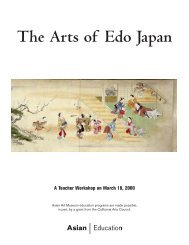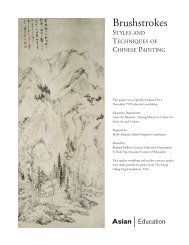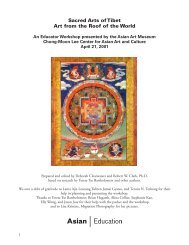Tea Bowl with Crane Design - Asian Art Museum | Education
Tea Bowl with Crane Design - Asian Art Museum | Education
Tea Bowl with Crane Design - Asian Art Museum | Education
You also want an ePaper? Increase the reach of your titles
YUMPU automatically turns print PDFs into web optimized ePapers that Google loves.
Who is the man in the picture? What is he doing?<br />
Sen Soshitsu is the fifteenth generation head of the Urasenke<br />
tradition which provides instruction in the “Way of <strong>Tea</strong>”<br />
(Chado; also known as Chanoyu, literally “hot water for tea”).<br />
He has written that this practice, though often called the “tea<br />
ceremony, “ is not really a ceremony or ritual at all, but a way<br />
of life based on the simple act of serving tea <strong>with</strong> a pure heart.<br />
Beyond its spiritual aspect, the “Way of <strong>Tea</strong>” allows participants<br />
to interact <strong>with</strong> other people, <strong>with</strong> nature, and <strong>with</strong> the<br />
environment on a basic, satisfying level.<br />
The photograph shows Sen Soshitsu preparing tea at an<br />
event to mark the <strong>Asian</strong> <strong>Art</strong> <strong>Museum</strong>’s re-opening in 2003.<br />
He is seated in a special tearoom installed in the museum’s<br />
Japanese art gallery, having just ladled hot water from an iron<br />
kettle that is heating on a brazier recessed into the floor. He<br />
<strong>Tea</strong> bowl (detail; B72P17).<br />
pours the hot water in a steady stream from a bamboo ladle<br />
into the tea bowl set before him on the mat. The utensils he<br />
uses and his carefully choreographed actions are both aspects<br />
of the practice that can be traced directly to the influential sixteenth century tea master Sen Rikyu<br />
(1522–1591). Sen Rikyu taught the way of tea to several samurai lords of his day.<br />
What is the object in the second picture? How was it used?<br />
The tea bowl is one of the most important utensils used in a tea gathering. A small quantity of powdered<br />
green tea is first removed from a tea container and placed into the bottom of the bowl. Water<br />
is added and the powdered tea and water are then blended together to form a bright green beverage,<br />
and the host presents the warm bowl of tea to his guest for drinking. After drinking the tea the guest<br />
carefully examines the tea bowl and the guest might comment on the bowl’s design, age, and beauty.<br />
For example, the crane decorating this bowl is an auspicious symbol associated <strong>with</strong> longevity and<br />
marital fidelity. Like most tea bowls, this one is made of clay, and has a soft, slightly pitted surface<br />
and ridged sides meant to rest comfortably in the drinker’s hands.<br />
What does this object tell us about the role of culture in samurai life?<br />
By the sixteenth century, the “Way of <strong>Tea</strong>” was wildly popular <strong>with</strong>in samurai society, as one of the<br />
cultural practices (bun) encouraged as a counterweight to military training (bu). Hideyoshi and<br />
Nobunaga, two of the great Momoyama era (1573–1615) warlords, were both ardent students of tea<br />
and collectors of tea bowls and other utensils. Nobunaga is even known to have awarded prized tea<br />
bowls to his vassals for meritorious duty in battle. It was their patronage of the tea master Sen Rikyu<br />
that led to his preeminence at the end of the sixteenth century.<br />
Rikyu favored simple, unadorned objects like this bowl as an expression of a kind of refined<br />
rusticity. Surprisingly, perhaps, the samurai valued this humble aesthetic even at a time when other<br />
art forms, such as painting, clothing, and even armor design showed a taste for flamboyant, bold,<br />
and colorful decoration made even more lavish <strong>with</strong> gold ornamentation.<br />
<strong>Asian</strong> <strong>Art</strong> <strong>Museum</strong> <strong>Education</strong> Department
















